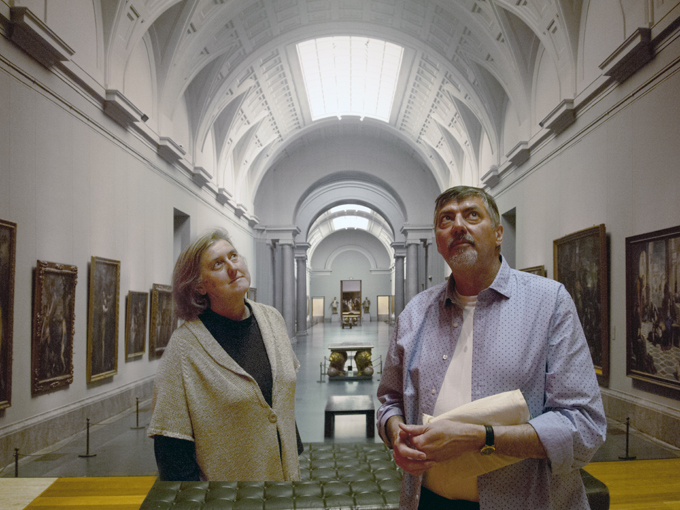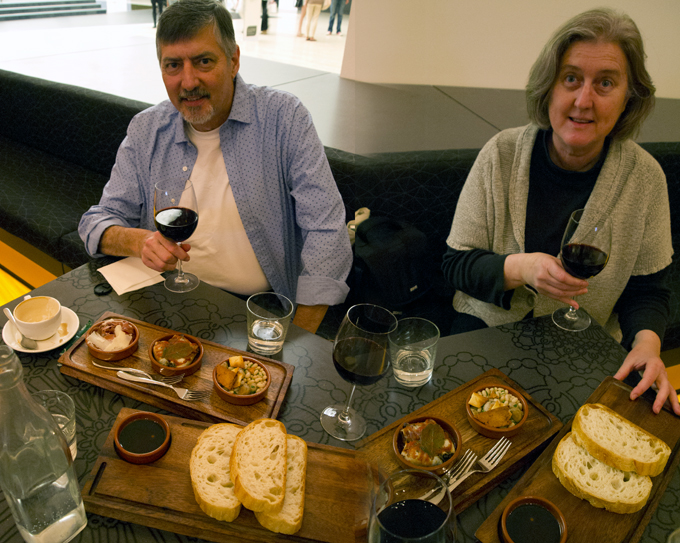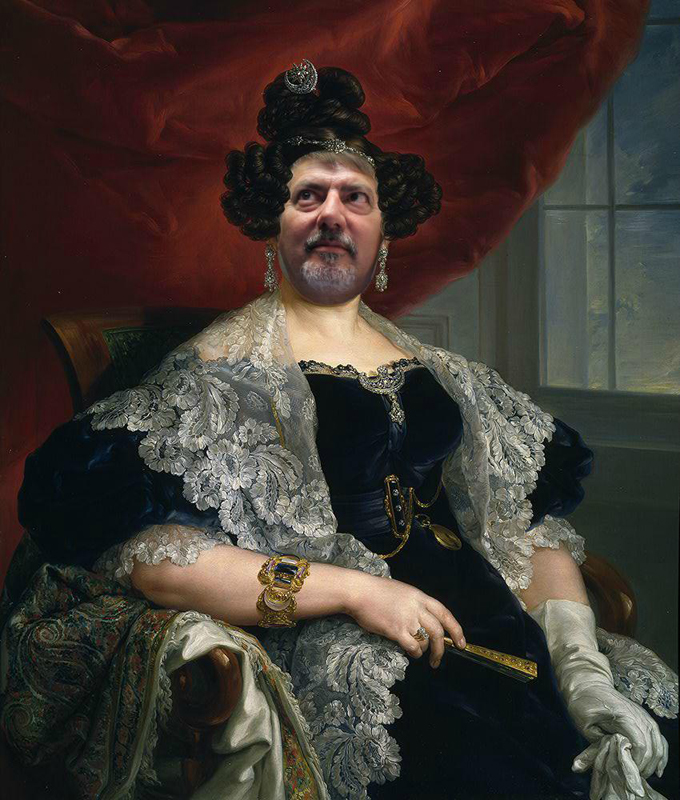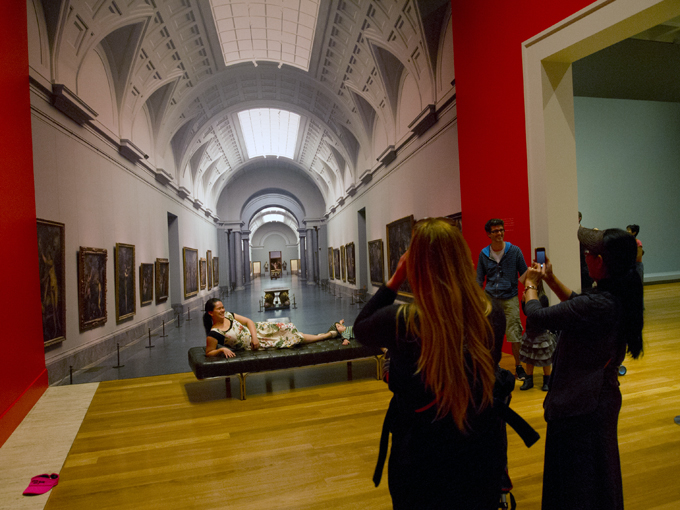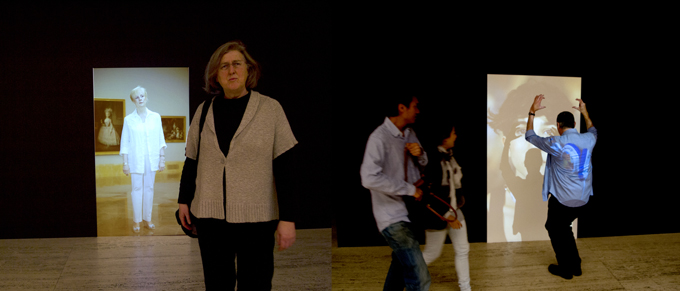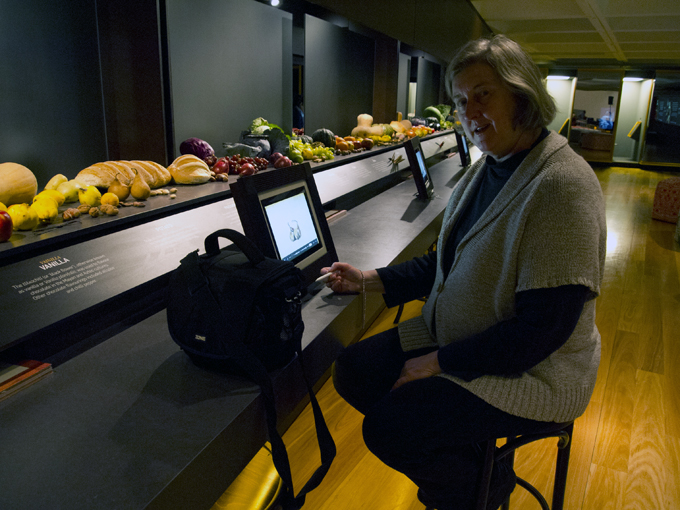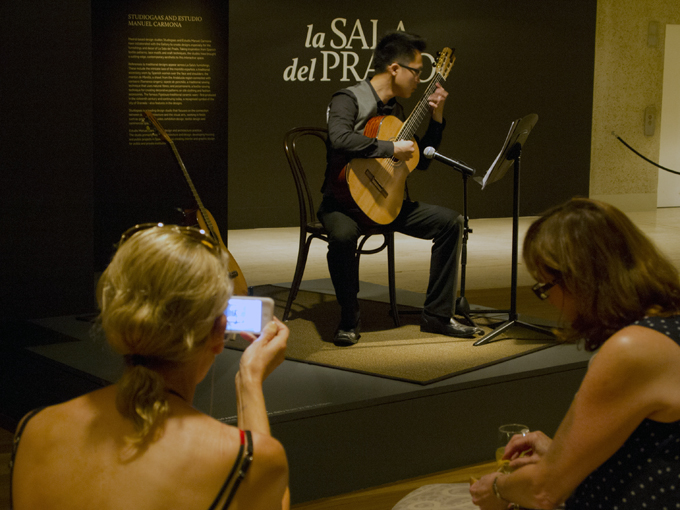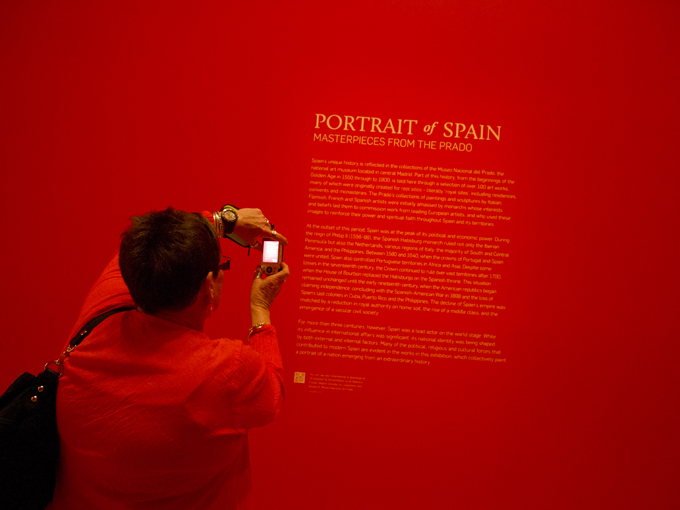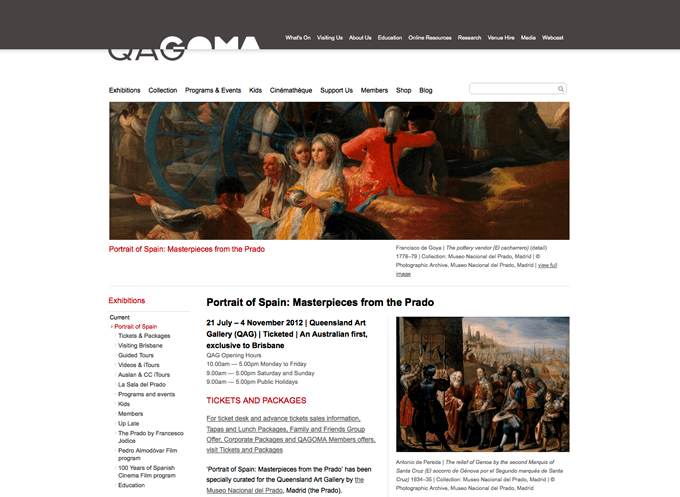Posts Tagged ‘Queensland Art Gallery’
FROM TOOWOOMBA TO SPAIN AND BACK AGAIN – IN 24 HOURS!
The fastest way for a Toowoomba person to get to Spain is to visit the Portrait of Spain—Masterpieces from the Prado exhibition at the Queensland Art Gallery. 100 paintings and prints are on loan from the Museo Nacional del Prado, Madrid. The QAG walls have been re-painted red and the gallery has been converted into a little Spanish culture experience.
We visited the show last Saturday and participated in what was offered to the viewer/attendee.
The paintings were magnificent examples of oil painting from the 16th-19th century. Spanish aristocracy, royalty, religious iconography, decorative still-life and court-life. There were no nude or clothed Majas, no Meninas nor swirling clouded El Greco landscapes however there were a few of the famous work to stir the interest. One work of huge scale and interest was Pereda’s The Relief of Genoa.
The exhibition is extended over many rooms and is broken into eras and subject matter. Didactic panels and QR coded prompts help the visitor to discover the curator’s spin on what they are seeing.
All in all the Spanish portraits seem a pretty interesting lot. Fine clothing, porcelain skin, mustashes (even on some women), dogs, horses drawfs and aloof expressions abound. Then you enter the Goya’s Disasters of War series—It’s a reminder that for much of the duration of time that this exhibition covers the Spanish were at war with most of Europe at one time or another and were exercising colonial power and plunder in Central America, the Phillipines and other places.
The last room of the exhibition features the 19th century—some predictible landscapes, one entitled ‘Landscape with sheep’, our own QAG Picasso La Belle Hollandaise and some works which didn’t seem to add to the narrative of Spain in the context of the emerging trends in world art at the time.
We breezed through the exhibition shop and were drawn to the Tapas Bar for lunch after which we were enticed to play with the ‘DIY interactive portrait photobooths’ and the still-life drawing stations accompanied by a Spanish guitar performance.
Seeing the exhibition is one thing but now, in the contemporary manifestation of gallery, we experienced a little more; Spanish culture, the work practice of the artist and other entertainment. We went to see a art exhibition and came away with so much more …
IAN POOLE: AIPP On the Lounge
Ian Poole is well placed to have an opinion about fine art photography and collecting photographs. He has been a major player in professional photography in Brisbane for nearly 40 years and is a respected AIPP judge with yearly invitations to also judge the New Zealand Institute of Professional Photography awards. Despite his professional photography connection he has been a part of a sector of the Queensland photographic art scene that extends from the early 1980s with Imagery Gallery, later with the Photographer’s Gallery and more recently with the Queensland Centre for Photography. He has completed a Graduate Diploma in Visual Arts from the Queensland College of Art and has been awarded an Australia Council residency in Tokyo. Adding to this he has curated photographic exhibitions in Japan (of Queensland photographers) and exhibitions in Australia (of local and Japanese photographers).
So when Poole offers commentary on aspects of the photographic art world of Brisbane and Queensland it should be something of an opportunity to connect with his extensive knowledge of the genre. Recently as part of the AIPP ‘On the Lounge’ lecture series Ian Poole presented to an assembled audience of around 40 a dissertation entitled, ‘Have you ever wanted to collect photographic art, or be collected as a photographic artist?’
Ian Poole began his presentation by reviewing recent art auction records for photographic artworks including those by Adams, Sexton and Dupain. Thousands, hundreds of thousands and even millions will change hands for well-known and rare works. The recent phenomena of Nick Brandt’s African work,which had been shown only weeks earlier in Brisbane, attracted some discussion. Perhaps some in the audience felt a little inspired by the possibility that, if they could enter the fine art field, that there was recognition and the possibility for a significant income to be made.
Poole introduced his collection of images that were hung on the walls and laid out on tables before the audience and discussed their histories and stories. For him the concept of ‘provenance’ elevated the importance of each work. A small Dupain image of the interior of the National Gallery in Canberra made during its construction was linked to his encounter with the work in a Brisbane gallery where it was purchased for a few hundred dollars. His most exuberant discussion related to a Joachim Froese diptych acquired when he swapped it with Joachim for a 4×5 enlarger. An expanded provenance trail led to it being loaned back to Joachim so that it could be displayed a QUT exhibition of his work.
A long-term friendship with north Queensland photographer Glen O’Malley presented some interesting provenance stories. O’Malley is not fully recognised for the significance of his practice in Queensland – he could probably claim to have had the first ‘photographic art’ exhibition in this state in the mid 1970s. Poole presented to the audience an image from O’Malley made as part of the Queensland Art Gallery’s 1988 Journeys North commission. The 20×24” black and white photograph showed a scene in Poole’s home where the O’Malleys were having dinner. The image was part of the accepted images for the Journeys North show and was subsequently published. Somehow Poole’s own life had become art photography itself.
Another photography collaborator presented by Poole was John Elliott. Well known for his documentation of country and western music and its heroes and doyens including Slim Dusty, Chad Morgan and Jimmy Little, Elliott is an enigmatic character of the photography scene. Ian spoke of John’s most recent show Gifted Country at the Caboolture Regional Art Gallery and his photobook publishing ventures. A recent journey to Townsville that Poole had shared with another of Queensland’s enigmatic photographers, Maris Rusis, resulted in a body of work by Rusis that dealt with the décor of budget north Queensland motel rooms. These small and fine gelatin silver fibre B&W prints presented to the audience the fact that traditional values remain key to some workers who continue to practice analogue photography in a digital world.
Question time brought up some difficult truths – Why does the Queensland Art Gallery/GOMA not seem to be collecting photography generated within this state? Did they ever collect? Some discussion related to the archival needs for conservation framing and presentation.
As a conclusion to the presentation Poole spoke of the way in which he and his photography acquaintances swapped and shared their works, and how much of his collection was built around the generosity of fellow photographers and their desire to share. He held a bundle of his own gelatin silver images up before the audience and made an offer that ‘you can have one of my prints this evening – and send a print to me as a swap. Start your collection this evening …’
While Ian Poole began his presentation with a review of the overtly mercantile auction scene, it seemed that his passion about photography, photographs, friends, shared experiences and the meaningfulness of the provenance of the works, that these things could not be commodified. He spoke of his collection of photos, books and ephemera as being an entity that would be bequeathed to his daughter Nicola, also a photographer and present at the talk. Through the audience he directed to Nicola to ‘treasure and look after these things … they were important, valuable – not only as the stories they depicted through their image on the front-side of the print, but also of the back-story of their origin and collection.’
There is no doubt that Ian Poole’s passion for photography and his understanding of how it operates at a personal and cultural level is something that was shared and communicated on this evening. And those present will be inspired to develop a new appreciation of what photographs are and what they can say about the human condition.
Doug Spowart May 20, 2012
An unusual meeting – Face-to-Face with an early portrait of one’s self – circa 1982 found in Poole’s collection
August 26, 2011 HENRI CARTIER-BRESSON Opens @ QAG
Henri Cartier-Bresson exhibition opens at the Queensland Art Gallery.
Can you get into trouble at an exhibition opening – doing what Henri did: Taking photos, that is?
The opening of Henri Cartier-Bresson’s exhibition The Man, The Image and The World at the Queensland Art Gallery was an event and an experience befitting the celebrated position that HCB holds within the genre of documentary photography. The exhibition was opened by Queensland Premier Anna Bligh, who spoke of a personal love interest in HCB’s work. The reason being, that her husband had given her the image, On the banks of the Marne, France 1938, as a gift while courting her in the 1980s.
The occasion was auspicious by the presence of swishy attired, mainly older people unknown to the writer who must have been art gallery members and patrons. Scattered here and there were photographers, who to me, also seemed of the older age group. It has been a long – long, time since an exhibition of photography such as this has gained entry to the QAG/GOMA duopoly – and perhaps the invitation list, at least the photographers one, may have originated in that long past era of the last photo show. Additionally it seemed strange that some important players in the world of photography including a now, local renowned photojournalist, who actually knew HCB, wasn’t on the invitation list but secured entry as guests or by unofficially passed on invites.
After the usual opening speeches the invitees were allowed access to the exhibition. The show takes in the history of the photographer’s work in around 250 individual mounted and framed images. Those familiar with the HCB oeuvre will no doubt shuffle from one iconic image to the next, lingering long enough to grasp the moment, the intensity of light and the message that Henri composed. This exhibition puts into perspective his remarkable career behind the camera. For many however, the sheer volume of imagery could be too much. HCB himself said ‘you’ve got to milk the cow a lot to make a little cheese’ but this cheese platter may be so rich it is beyond quadruple Brie!
HCB worked as a photographer over a significant period of time, the exhibition media release quotes 70 years (although this may be misleading if we follow the HCB Foundation’s chronology of his first photographs being made in 1931 and then retiring in 1974 to take up drawing). He photographed portraits, the world in turmoil, the street corner and moments of poetry in everyday life. He lived, and worked, in a time where images were cherished, published and communicated. A time when photographers revered each other’s work and banded together to ‘make a difference’ to the world through the truthfulness of their lens and mass communication of journals like George Luce’s LIFE magazine. In its day the magazine was the TV news and the up-to-the-minute blog post – the world was a wide and weird place and HCB used his trusty Leica as a divining rod to seek out the unfamiliar and in doing so make order from the chaos of the continuum of time.
HCB was aided in the making of his distinctive photo work by his training under the tutelage of the cubist André Lhote and Cartier-Bresson’s passion for surrealism. It is often quoted that he found reality stranger that anything he could conjure up in his mind – so he took up photography. HCB, was inspired to photograph in particular, after seeing an image by Martin Munkacsi entitled Three boys at Lake Tanganyka 1930, of silhouetted boys running into surf.
Commentators on his HCB’s work such as Clement Greenberg (1964) described him as an ‘art photographer’ and added that ‘even among painter-photographers he stands out by the sophistication of his art consciousness[i]’. Art historian Ernst Gombrich (1978) honing in on HCB’s artist-training background claims that everything in our environment ‘resonates in our mind, tough we are rarely fully aware of these reverberations. It needs an artist to make us attend to the message of reality. Henri Cartier-Bresson is such an artist.[ii]’ Interestingly the ‘artist’ tag was played down by photographers who thought of him as being a ‘photographer’. None-the-less by 1974 HCB had had enough of photography and returned to his beloved drawing which he continued to practice until his death in 2004.
The world of 2011 is a different place to that which was inhabited by the camera toting HCB. Today he could be arrested, or at least hassled by police or overly protective parents for attempting to make the kind of photos for which he is famous. In 2011 he would have problems getting his work published as essays in major magazines usually don’t allow such in depth reportage. He may have been required to shoot in colour. He would still be able to pursue gallery exhibition and book publishing – one could even imagine a HCB Blurb book or two and maybe an online sales website. Could HCB have accepted the death of film, the spectre of the digital age and digital enhancement, and the public’s scepticism of the photo as truth? It’s interesting to note HCB disciple Sebastio Salgado has made the switch to digital and is proudly advertising his use of DXO film emulation software to enable his digital later images to have the same ‘look’ and grain ‘feel’ of the early film photos.
Ultimately one needs to ask the question ‘is Cartier-Bresson’s work meaningful today?’ Some, including this writer, may consider HCB a significant influence and guide in their personal practice as documentary photographers. Others will trace the meaning of the photographs as a thread that runs through their own lived experience – for them the images are touchstones for nostalgia and remembrance. Contemporary photographers may be inspired to emulate the ‘decisive moment’ and stage it in tableaux a la Jeff Wall, because that’s how it would be done today. We could lament the fact that the huge curatorial interest invested in iconising Cartier-Bresson many cause other, perhaps equally brilliant photodocumentary workers, to end up being overlooked. Wouldn’t it have been perhaps fitting for the QAG to have curated a companion show that could have provided an Australian context for HCB’s local peers and followers.
Admittedly the allure of the HCB street photographer persists today for many young practitioners. If they get a chance to see this work they may respect the provenance of their trade and find inspiration making documents of life as candid moments. This new work will enter the public record to feed the need for future nostalgia binges – for those who can remember, and be faithful documents of these times for those who aren’t born yet, to peer at and think how quaint it must have been to alive then.
After seeing the show I went home and pulled out my old Leica M3. I held it in my hands and reverently fired off all the shutter speeds several times, I pined for the times past when we were inseparable, before putting it back, as HCB had done so many years before, in safe storage.
Doug Spowart September 17, 2011

